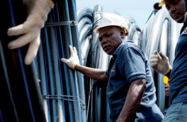Ghana’s mining industry could see investment levels rise on the back of government efforts to improve the business environment and announcements that key gold mines are preparing to reopen or expand operations.

In February the South African-headquartered AngloGold Ashanti, the world’s third-largest gold producer, which also operates the Iduapriem gold mine 70 km north of Takoradi in western Ghana, announced it had signed an agreement with the government to redevelop the Obuasi mine, located in the Ashanti Gold Belt in the south of Ghana.
The company halted operations at the mine in 2014 on the back of a drop in commodity prices.
Under the new agreement AngloGold will invest between $450m and $500m over the next two and a half years to develop the mine into a more modern, mechanised operation. In return, the mining firm has been granted tax concessions and a security force to guard against the challenge posed by illegal mining.
Production, which is set to restart by the third quarter of 2019, is expected to reach 2000 tonnes per day in the first year of operation, before rising to a daily output of 5000 tonnes thereafter, with the project expected to generate between 2000 and 2500 jobs.
The Obuasi announcement was followed by news in early March that Australian company Azumah Resources had expanded operations at its Wa Gold project in the country’s north-west, after drilling at the Manwe prospect identified six potential shear zones. In total the Wa Gold project holds an estimated 2.1m oz of minerals.
South-African firm GoldStone Resources has also outlined plans to reopen a mine located within the Akrokeri Licence, in which it holds a 100% interest. After assessing recent drilling data, the company is undertaking a review to potentially reopen the former underground workings, which could lead to a resumption in production.
The mine, which is adjacent to the Obuasi mine, produced some 75,000 ounces of gold between 1904 and 1909, when it closed due to flooding.
In addition to Akrokeri, Goldstone also holds a 90% interest in the neighbouring Homase licence. Together the projects hold around 602,000 oz of gold.
Energy reforms & quality controls behind spike in activity
The renewed mining activity comes amid government efforts to attract more investment to the sector, which is a key growth driver for the economy.
As the world’s 11th-largest gold producer, the country generated $5.8bn from gold exports last year, up 17.6% from 2016, according to the Bank of Ghana.
In order to improve the business environment for producers, on March 5 the Public Utilities Regulatory Commission announced a reduction in energy tariffs of 10-30% for various categories of consumers, effective from the middle of the month.
Industry officials forecast that mining firms could save around $2-3m per year as a result, significantly lowering the cost of doing business and attracting more players into the market.
Moves made earlier this year to standardise quality controls on gold exports could also instil more confidence into the sector. In February the decision was made to transfer the assessment and valuation of gold exports to the state-run Precious Minerals Marketing Company. Previously, private companies were responsible for grading their own gold, and the lack of oversight led to concerns over incorrect valuations of the commodity.
The Minerals Commission is also playing a strong role in supporting sector growth, announcing in January that it was adopting a three-pronged approach to attract investment. This will involve introducing an online application and processing system to reduce delays in the approval of mineral rights, improving training for small and medium-sized businesses delivering goods and services to the sector, and efforts to help develop small-scale miners into medium and larger enterprises.
Ghana’s improved economic situation could also be a factor encouraging increased investment. The World Bank forecasts growth of 8.3% this year, the highest in sub-Saharan Africa, while a drop in inflation, stabilisation of the cedi and a reduction in the fiscal deficit are expected to further improve investor appetite.
Illegal mining poses a challenge to growth
Despite the recent increase in activity and efforts to improve the business environment, the mining industry still faces some significant hurdles.
The most pressing is illegal mining, known locally as galamsey, which over the past decade has seen the establishment of many unregistered, small-scale mining operations.
Ghana loses approximately $30bn each year from illegal mining and smuggling activities, according to Kwabena Frimpong-Boateng, the minister of environment, science and technology, who spoke at the inauguration of municipal and district committees against illegal mining in January. The practice has also affected the country’s cocoa industry, with many former plantations in recent years being used for mining.
To combat the losses, last year the government launched a 400-strong military and police taskforce to identify galamsey operations, along with the $3m purchase of drones to survey at-risk land; however, in January the government announced it would be extending its efforts after successfully closing down just 15% of its illegal mines target.


